Strong, well-defined shoulders do more than just look impressive; they play a crucial role in your overall fitness and posture. Whether you’re lifting weights, playing sports, or performing everyday tasks, your shoulders support a wide range of movements. That’s why a consistent shoulder workout is essential for building strength, stability, and balance.
A shoulder workout targets key muscles such as the deltoids, traps, and rotator cuff, helping you achieve both aesthetic and functional results. Regular training improves upper body strength, enhances athletic performance, and reduces the risk of injury. For beginners and experienced lifters alike, knowing which exercises to include and how to structure a routine makes all the difference.
In this guide, you’ll discover effective workout routines in gym settings, using dumbbells, and a full shoulder workout you can follow today. We’ll also cover common mistakes to avoid, warm-up and cool-down tips, and how to structure your sessions for maximum results. By the end, you’ll have a clear, actionable plan to strengthen and tone your shoulders safely and effectively.
You can also listen to our Podcast here.
Anatomy of the Shoulder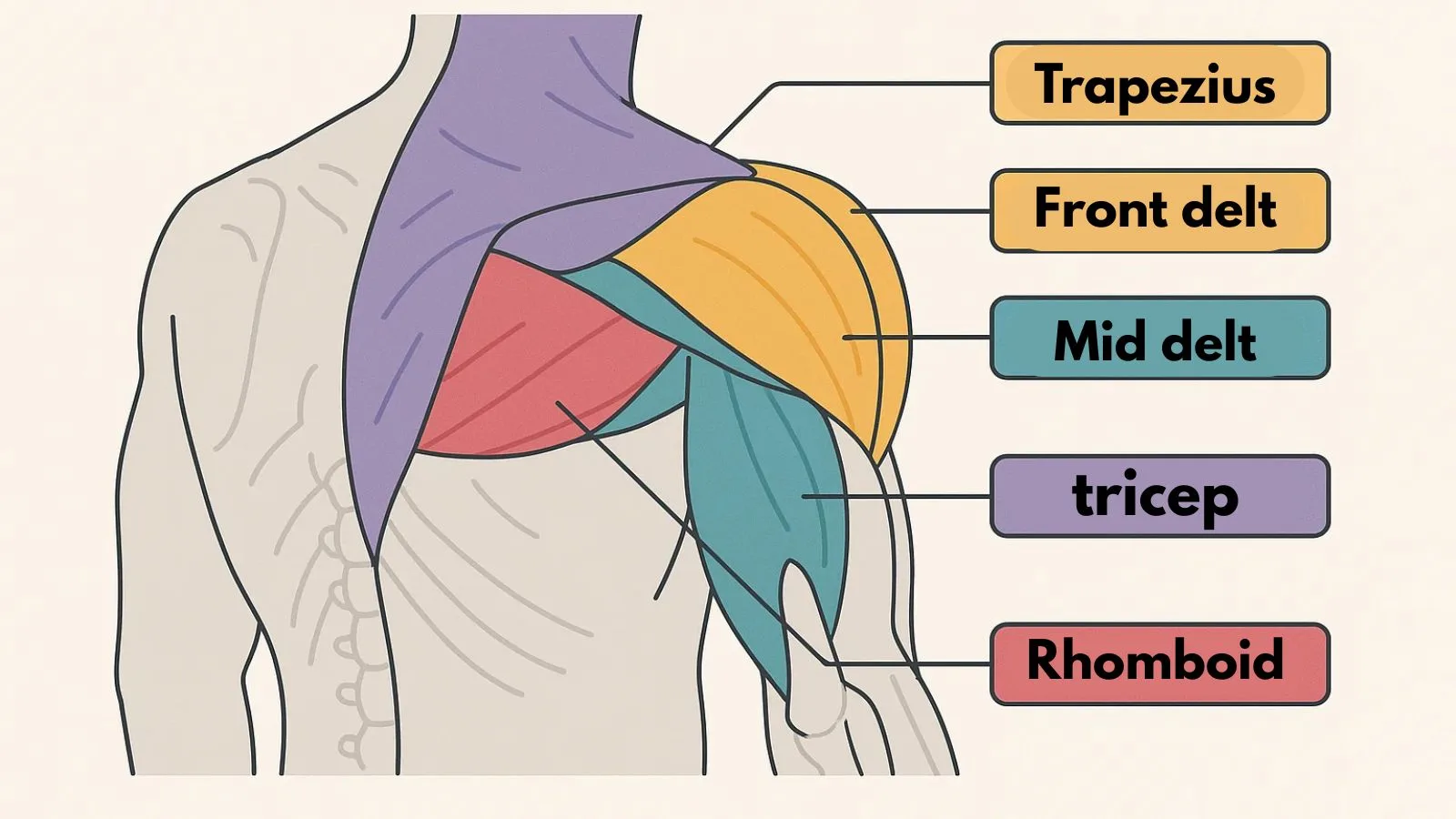
Understanding the shoulder’s anatomy is essential to getting the most out of any shoulder workout. The shoulder is one of the most mobile joints in the body, allowing a wide range of movements. Its complexity also means it needs proper training to prevent injuries and build balanced strength.
The main muscles targeted during shoulder exercises include:
- Deltoids: These are the primary shoulder muscles, divided into three parts:
- Front (anterior) delts: Responsible for lifting the arm forward.
- Middle (lateral) delts: Give width to the shoulders and assist in lifting the arms sideways.
- Rear (posterior) delts: Help pull the arms backward and support good posture.
- Trapezius (traps): Upper back muscles that stabilize and support shoulder movements.
- Rotator Cuff: A group of smaller muscles that surround the shoulder joint, providing stability and enabling controlled movements.
Targeting all parts of the shoulder is key to a well-rounded and effective shoulder workout gym routine or at home. Neglecting certain areas can lead to imbalances, poor posture, or injury.
By understanding how these muscles work together, you can select exercises that strengthen each component, ensuring both functional strength and a toned, aesthetic appearance.
Benefits of a Shoulder Workout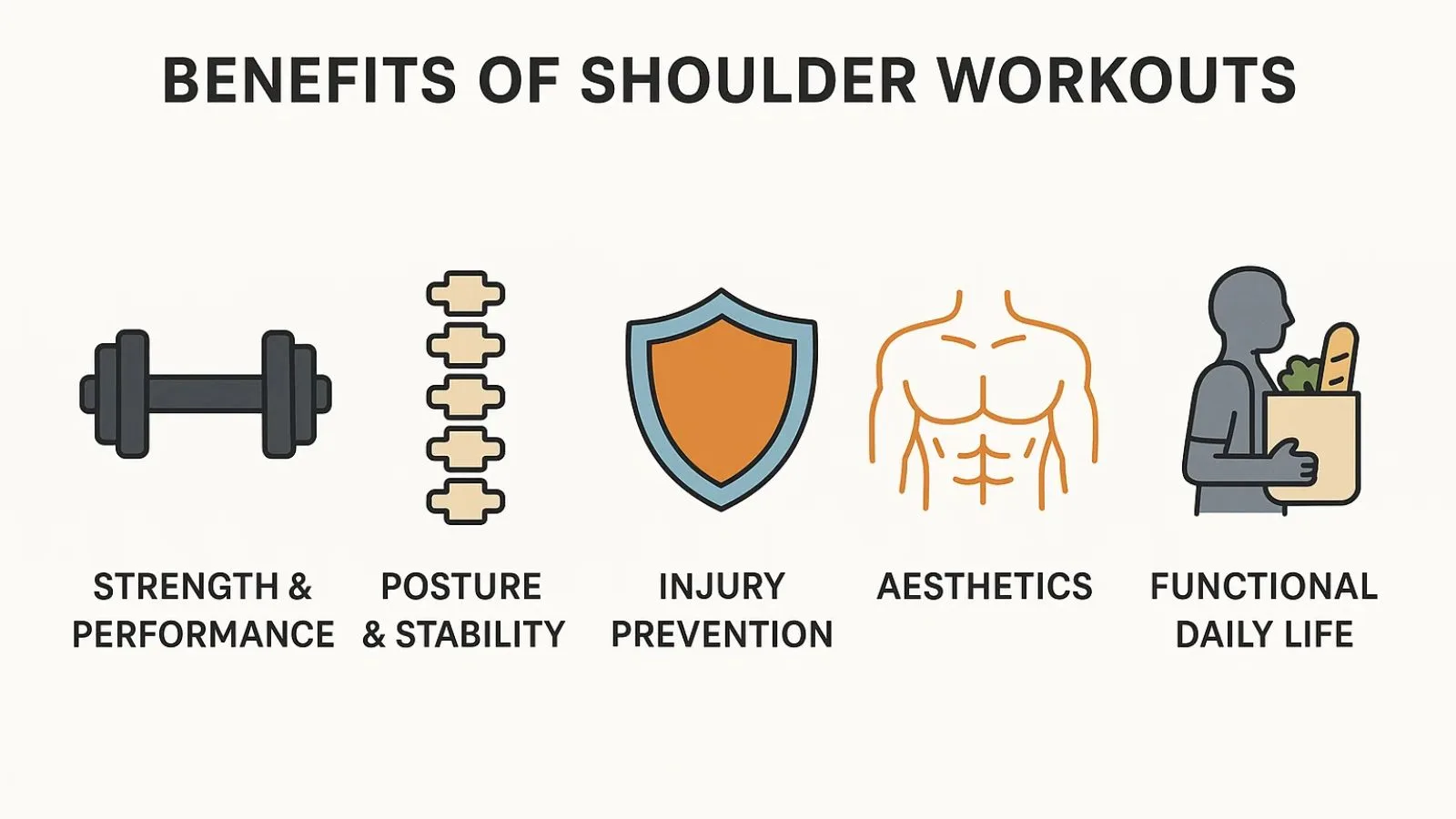
Incorporating a regular shoulder workout into your fitness routine offers numerous advantages, both for aesthetics and overall health. Strong shoulders improve posture, enhance upper body strength, and contribute to a balanced physique.
1. Improved Strength and Performance
Shoulder exercises target the deltoids, traps, and rotator cuff, which play a key role in pushing, lifting, and pulling movements. Strengthening these muscles enhances performance in weightlifting, sports, and everyday tasks.
2. Better Posture and Stability
Weak shoulders can lead to rounded shoulders or slouching. A consistent shoulder workout in gym helps maintain proper alignment and stability, reducing the risk of strain and injury, especially in the neck and upper back.
3. Injury Prevention
Strong, balanced shoulder muscles protect the joint from overuse and common injuries. Targeting all parts of the shoulder, including the rear delts and rotator cuff, ensures the joint remains stable during dynamic movements.
4. Aesthetic Benefits
Well-developed shoulders create a strong, defined upper body. Broad shoulders complement other muscle groups and improve overall body proportions, making your physique look more balanced and athletic.
5. Functional Everyday Benefits
Strong shoulders make daily activities—like lifting groceries, carrying children, or moving furniture—easier and safer. Functional strength gained from shoulder exercises translates directly to improved quality of life.
With all these benefits, a structured shoulder routine is essential for both beginners and advanced lifters looking to build strength, definition, and mobility.
Warm-Up Before Your Shoulder Workout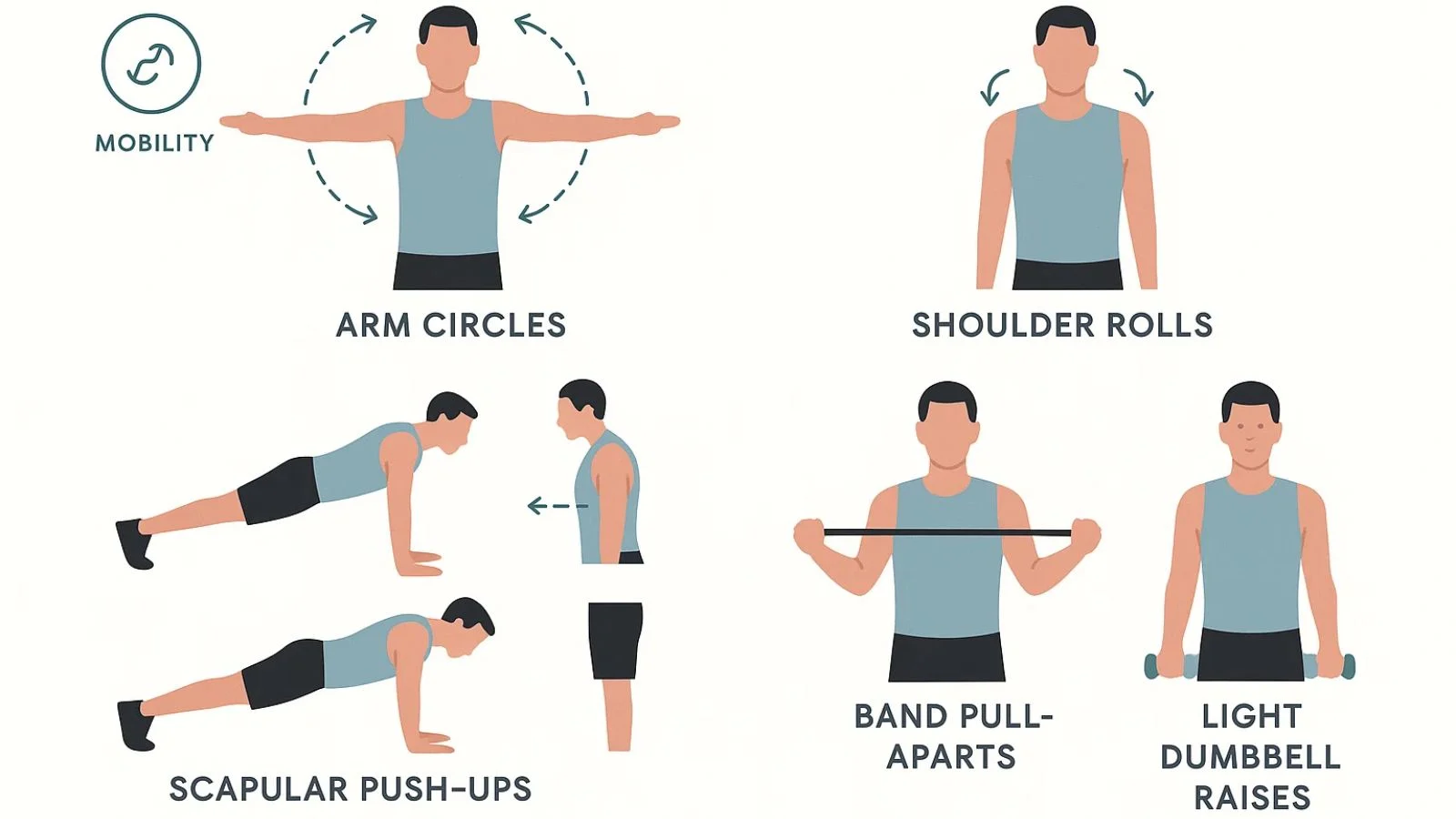
A proper warm-up is essential before starting any shoulder workout. Warming up increases blood flow, improves joint mobility, and reduces the risk of injuries. Skipping this step can lead to strains or overuse injuries, especially when lifting weights.
Dynamic Stretches
Start with dynamic stretches that engage the shoulder muscles:
- Arm Circles: Small to large circles forward and backward for 30 seconds each.
- Shoulder Rolls: Roll shoulders forward and backward to loosen traps and delts.
- Scapular Push-Ups: Engage the shoulder blades while keeping arms straight, 10–12 reps.
Light Activation Exercises
Use light resistance to activate the muscles:
- Resistance Band Pull-Aparts: Strengthen rear delts and upper back, 12–15 reps.
- Front and Lateral Raises with Light Dumbbells: Warm up anterior and lateral delts, 10–12 reps.
Mobility Work
Incorporate exercises that improve joint range of motion:
- Internal and External Rotations: Using light resistance or bands to activate rotator cuff muscles.
Spending 5–10 minutes on these warm-up exercises prepares your shoulders for more intensive shoulder exercises in gym sessions, improving performance and reducing the risk of injury.
Essential Shoulder Exercises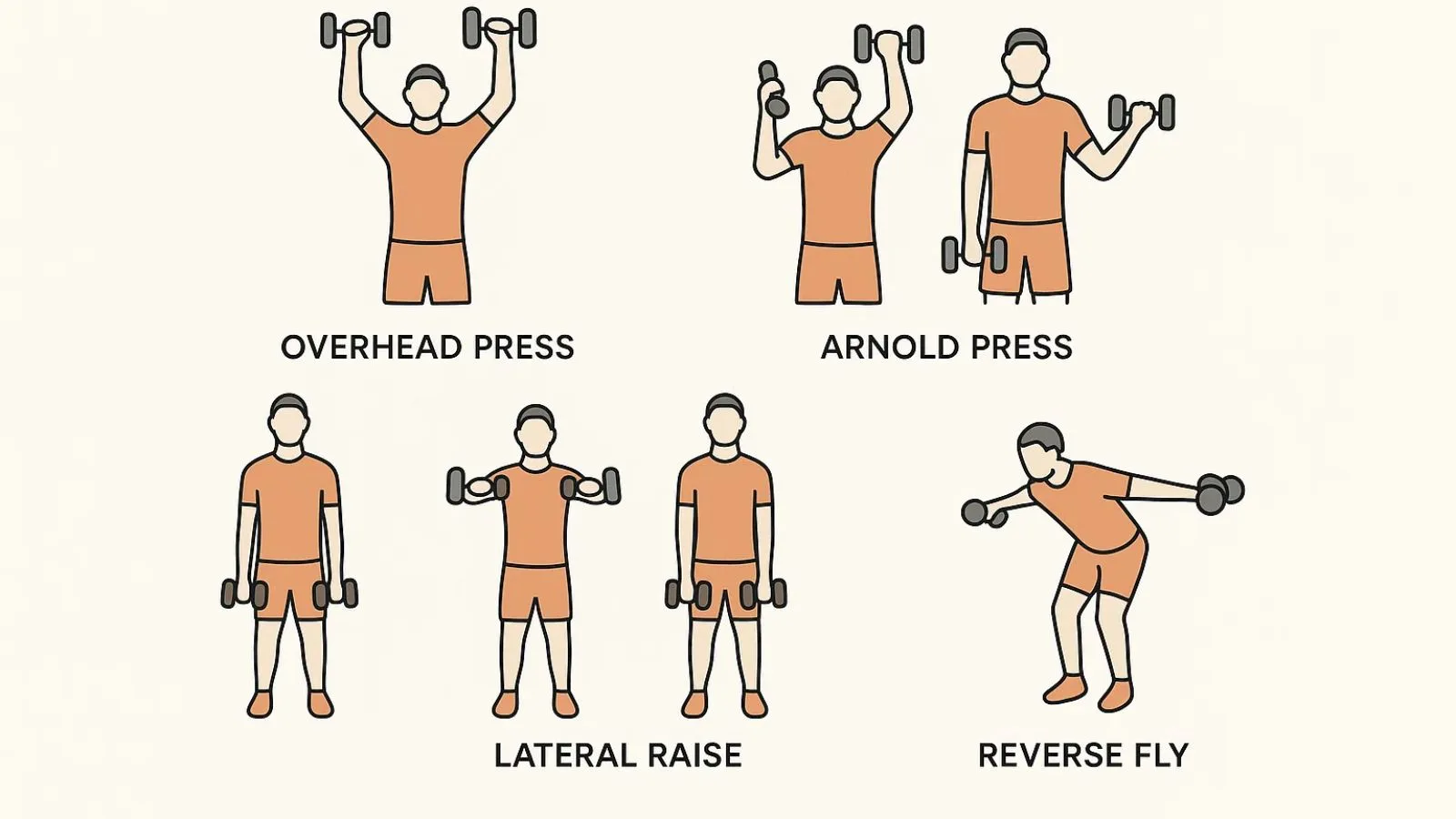
A well-rounded shoulder workout combines compound and isolation exercises to target all shoulder muscles, including the deltoids, traps, and rotator cuff. Here’s a list of essential exercises you can do in the gym or at home with dumbbells.
1. Overhead Press
The overhead press is a fundamental compound movement that works the front and middle delts. Sit or stand with a dumbbell in each hand at shoulder height and press upwards until arms are fully extended. Perform 3 sets of 8–12 reps.
2. Arnold Press
Named after Arnold Schwarzenegger, this dumbbell exercise engages all three deltoid heads. Start with palms facing your body, press the weights overhead while rotating your palms outward. Do 3 sets of 10 reps.
3. Lateral Raises
Lateral raises isolate the middle delts, creating width in the shoulders. Hold a dumbbell in each hand and lift your arms to the side until parallel with the floor. Keep a slight bend in the elbows. Perform 3 sets of 12–15 reps.
4. Front Raises
Front raises target the anterior delts. Lift dumbbells straight in front of you to shoulder height and lower slowly. Do 3 sets of 12 reps.
5. Reverse Fly
This exercise strengthens the rear delts and traps, which are often neglected. Bend slightly forward, hold dumbbells, and lift your arms out to the sides. Complete 3 sets of 12–15 reps.
These shoulder exercises in gym or at home with dumbbells form the foundation of a balanced and effective shoulder workout. Prioritize proper form and controlled movements to maximize results and prevent injury.
Full Shoulder Workout Routine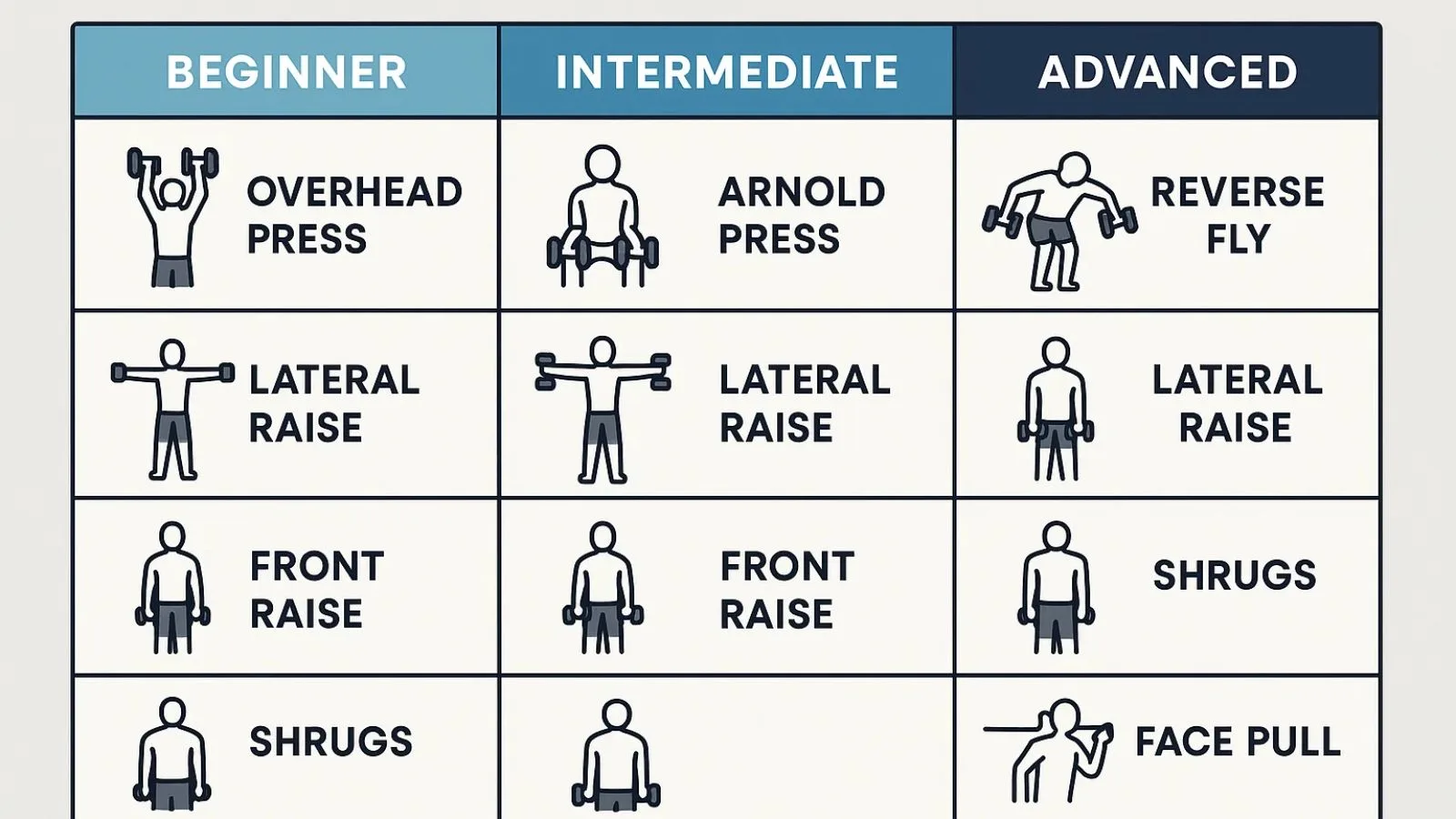
To get the most from your shoulder workout, it’s important to follow a structured routine. Here’s a sample full shoulder workout you can do in the gym or at home with dumbbells, designed for different fitness levels.
Beginner Routine
- Overhead Press: 3 sets of 8–10 reps
- Lateral Raises: 3 sets of 12 reps
- Front Raises: 3 sets of 12 reps
- Reverse Fly: 3 sets of 12–15 reps
- Rest 60–90 seconds between sets
Intermediate Routine
- Arnold Press: 3 sets of 10 reps
- Overhead Dumbbell Press: 3 sets of 10 reps
- Lateral Raises: 3 sets of 15 reps
- Face Pulls (Cable or Band): 3 sets of 12–15 reps
- Front Raises: 3 sets of 12 reps
- Rest 45–60 seconds between sets
Advanced Routine
- Military Press: 4 sets of 8–10 reps
- Arnold Press: 4 sets of 10 reps
- Dumbbell Lateral Raises with Pause: 3 sets of 15 reps
- Reverse Fly with Slow Tempo: 4 sets of 12 reps
- Front Raises with Plate or Dumbbells: 3 sets of 12 reps
- Optional Shrugs: 3 sets of 15 reps
- Rest 30–60 seconds between sets
This full shoulder workout routine targets all major shoulder muscles, including front, lateral, and rear delts, as well as supporting traps. By following these structured exercises, you can achieve balanced strength, definition, and mobility.
Remember to maintain proper form, control the weights, and progressively increase load over time for the best results.
Common Mistakes to Avoid
Even with a solid shoulder workout, mistakes can limit results or cause injury.
- Poor Form
Lifting too heavy or using improper technique can strain the shoulders. Focus on controlled movements, especially during overhead presses and lateral raises.
2. Skipping Warm-Ups
Neglecting warm-ups increases the risk of injury. Always spend 5–10 minutes on dynamic stretches and light activation exercises before starting your routine.
3. Ignoring Rear Delts
Many people overemphasize front and lateral delts, neglecting the rear delts. Include exercises like reverse fly and face pulls to maintain balance and prevent posture issues.
4. Overtraining
Shoulders are smaller muscles and recover more slowly than larger groups. Avoid training them every day; 2–3 sessions per week is sufficient.
5. Neglecting Progressive Overload
To gain strength and size, gradually increase weights or repetitions over time. Sticking with the same load can stall progress.
Avoiding these mistakes ensures your shoulder exercises in gym or at home with dumbbells are safe and effective, helping you build stronger, more defined shoulders consistently.
Also read,
How to Track Your Progress?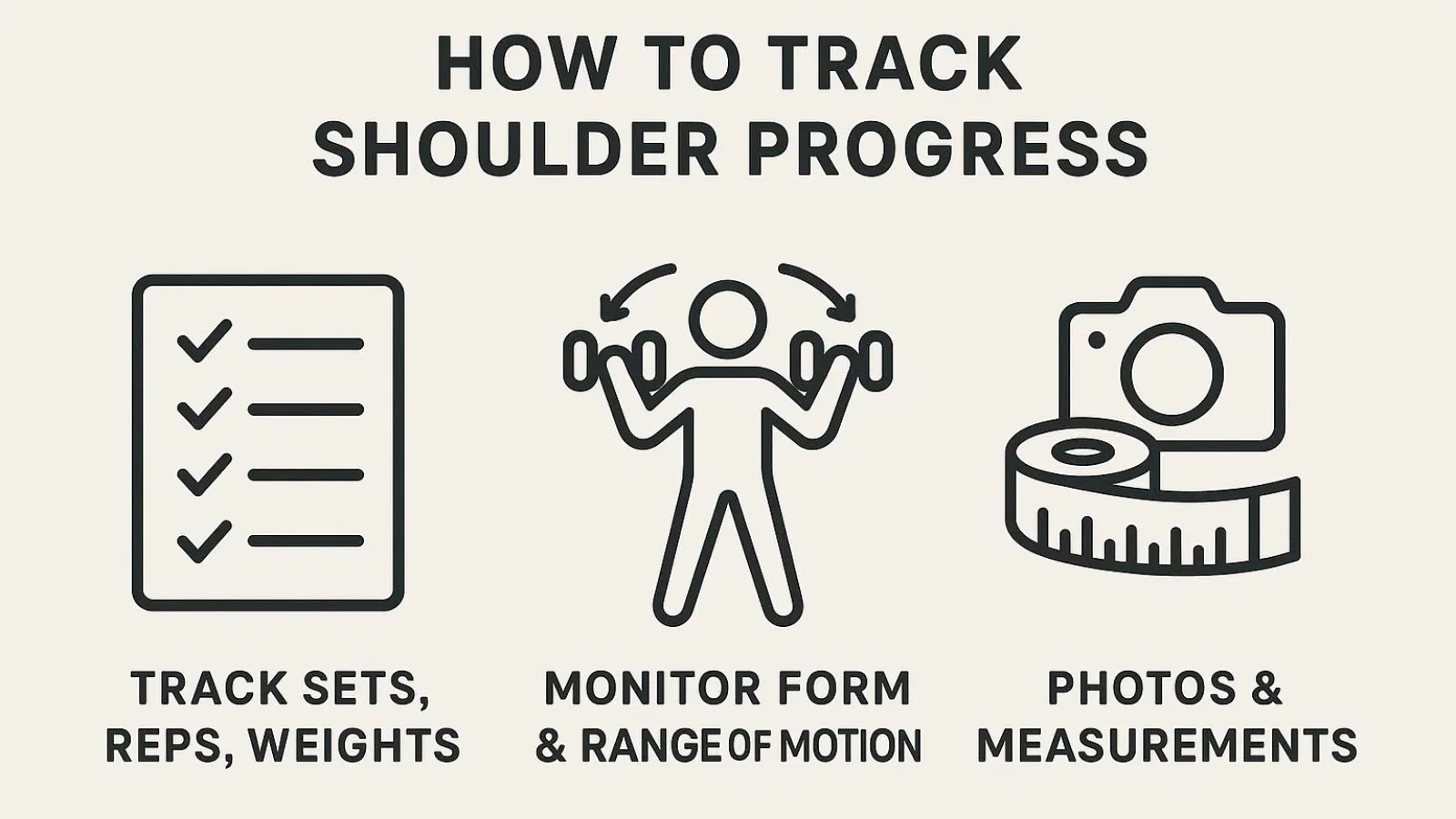
Tracking your progress is essential to ensure your shoulder workout is effective and that you continue to build strength and definition over time. Without monitoring, it’s easy to plateau or miss areas that need improvement.
1. Track Sets, Reps, and Weight
Record the number of sets, repetitions, and weights used for each exercise. This helps you progressively increase resistance, which is key to muscle growth and strength.
2. Monitor Form and Range of Motion
Pay attention to how smoothly you perform exercises. Tracking your form ensures you are targeting the correct muscles and avoiding injury, especially in exercises like overhead presses and lateral raises.
3. Take Photos and Measurements
Visual records, like progress photos or shoulder measurements, help you notice subtle changes in muscle definition and size that might not be obvious in the mirror.
By consistently tracking your shoulder exercises and overall performance, you can fine-tune your routine, stay motivated, and achieve stronger, more defined shoulders safely and efficiently.
Cool Down and Recovery Tips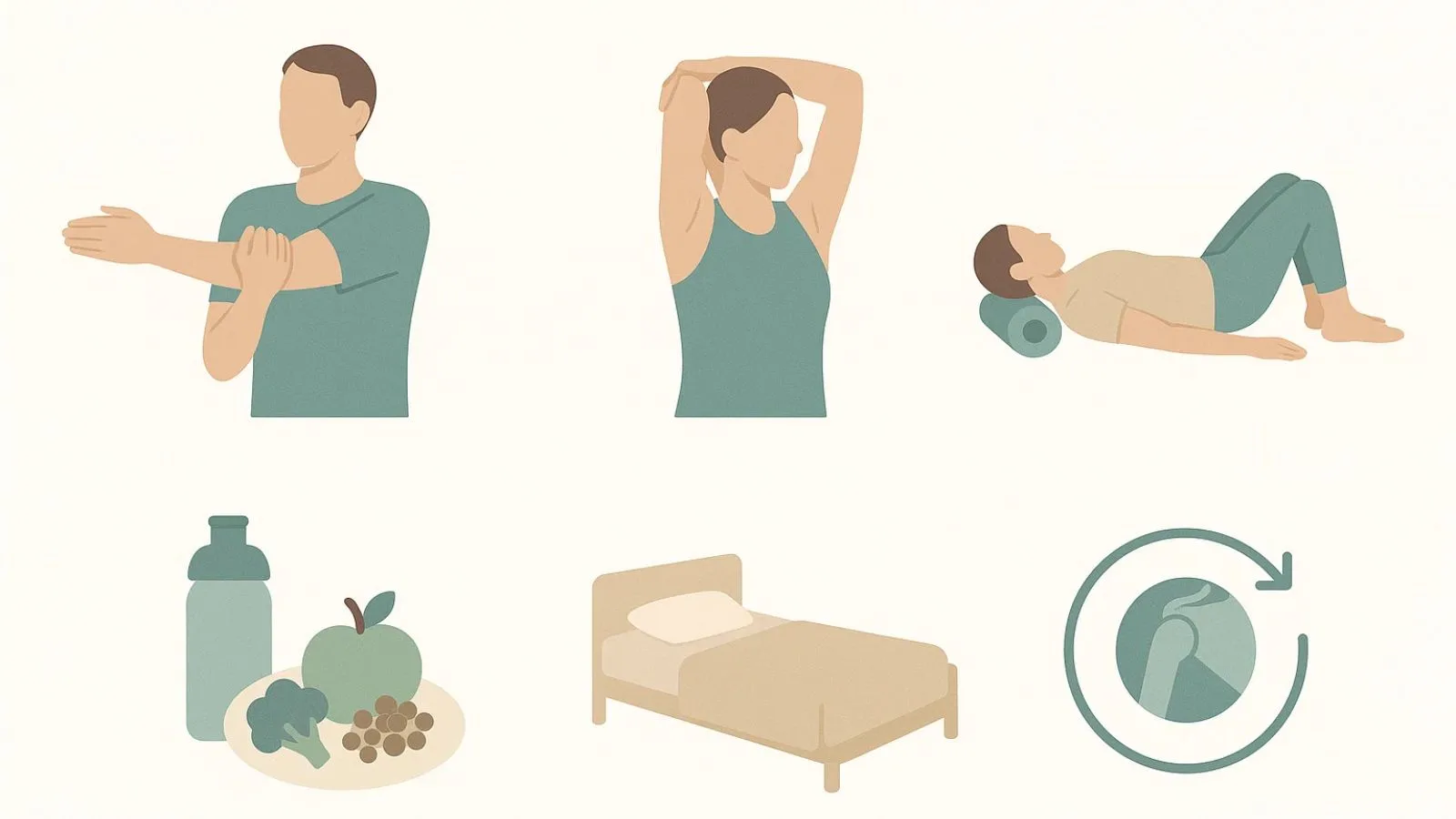
Proper cool down and recovery are just as important as the shoulder workout itself. They help reduce muscle soreness, prevent injuries, and promote overall shoulder health.
1. Stretching
Focus on static stretches for the shoulders and upper back. Examples include:
- Cross-Body Shoulder Stretch: Pull one arm across your chest and hold for 20–30 seconds.
- Overhead Triceps and Shoulder Stretch: Raise one arm overhead, bend the elbow, and gently pull with the opposite hand.
2. Foam Rolling
Foam rolling the upper back and shoulder muscles can relieve tightness and improve blood circulation. Roll each area for 1–2 minutes to enhance recovery.
3. Rest and Recovery
Allow your shoulders 48–72 hours of rest between intense workouts. Overtraining can lead to fatigue and reduce strength gains.
4. Nutrition and Hydration
Proper protein intake, balanced meals, and staying hydrated help repair muscles and support growth.
5. Light Mobility Work
Gentle movements or low-weight exercises on off-days maintain shoulder mobility without overloading muscles.
Following these cool-down and recovery strategies ensures that your shoulder exercises in gym or at home remain safe, effective, and sustainable over the long term.
How Calorie Intake Impacts Shoulder Growth?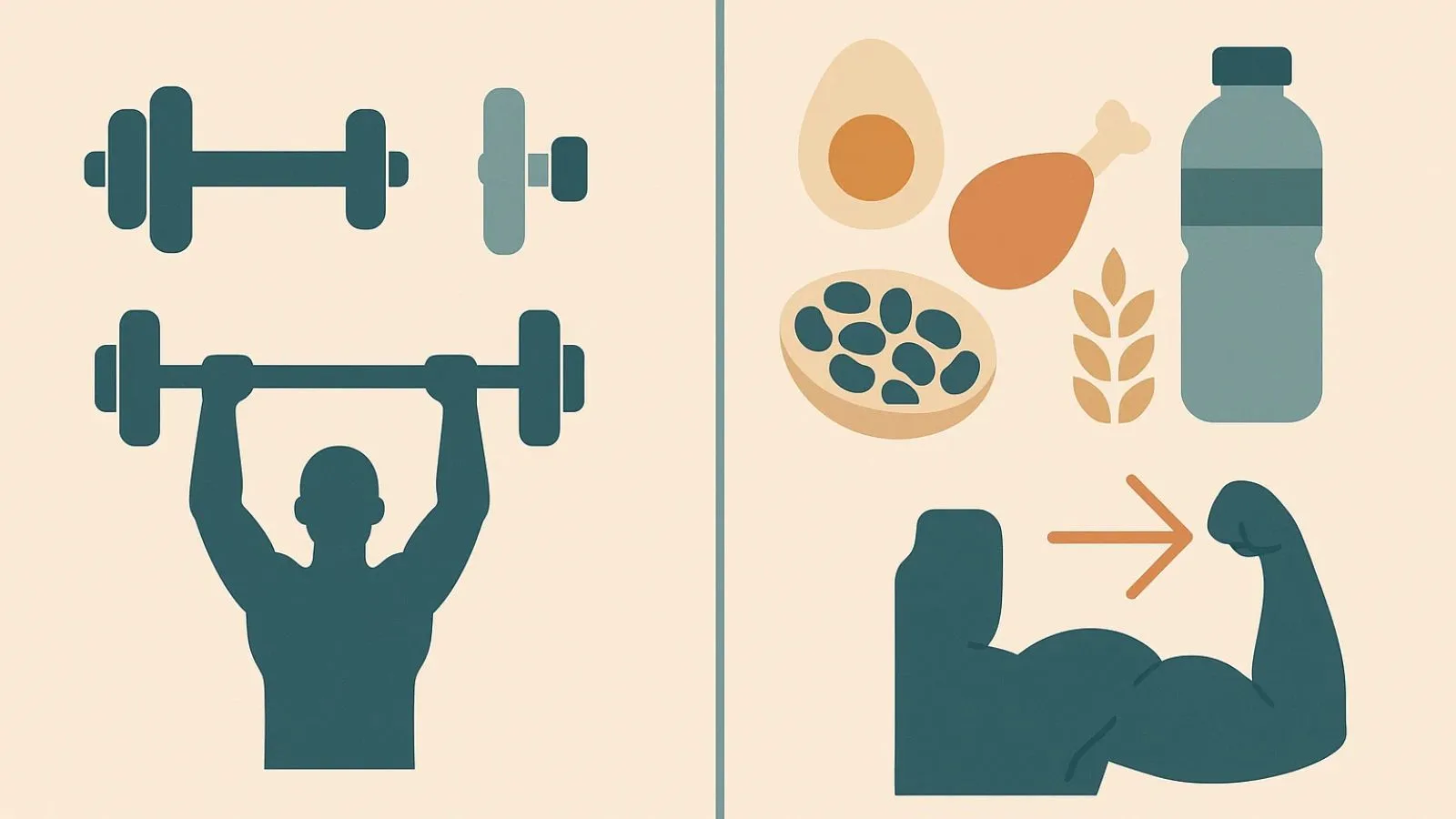
Building strong, defined shoulders isn’t just about exercise—it’s also about fueling your body properly. Increasing your calorie intake, particularly from protein and nutrient-dense foods, provides the energy your muscles need to grow and recover after a shoulder workout.
When you train your shoulders with exercises like overhead presses, lateral raises, and reverse flys, you create small microtears in the muscle fibers. The repair process, which leads to muscle growth, requires adequate calories and protein. Without enough nutrition, your muscles won’t recover efficiently, limiting gains.
A slight calorie surplus can support hypertrophy while ensuring you have enough energy for high-intensity shoulder exercises in gym sessions. Focus on high-quality sources like lean meats, eggs, dairy, legumes, whole grains, and healthy fats. Adequate hydration and micronutrients, like vitamins and minerals, also contribute to muscle recovery and joint health.
By combining structured shoulder routines with proper calorie intake, you maximize muscle growth and achieve stronger, more defined shoulders over time.
How CalorieTrackerBuddy.com Can Support Your Shoulder Gains?
Tracking your nutrition is as important as tracking your exercises for optimal shoulder growth. CalorieTrackerBuddy.com makes it easy to log your meals, monitor calorie intake, and ensure you’re eating enough to support your shoulder workout goals.
With this tool, you can:
- Log daily calorie and macronutrient intake.
- Track protein, carbs, and fats to fuel muscle growth.
- Monitor progress over time with detailed charts and reports.
By keeping your nutrition on point, you can ensure that your body has the energy and nutrients needed for exercises like lateral raises, overhead presses, and dumbbell front raises. Proper tracking also prevents under-eating or over-eating, helping you maintain a balanced diet that supports recovery and muscle growth.
Whether you’re a beginner or an advanced lifter, using CalorieTrackerBuddy.com alongside your shoulder workout with dumbbells or gym routine allows you to maximize gains efficiently. Tracking both workouts and calories ensures a consistent approach to building stronger, more defined shoulders.
Final Thoughts
A consistent shoulder workout is key to building strength, improving posture, and achieving well-defined shoulders. By targeting all major muscle groups—including front, lateral, and rear delts—you ensure balanced development and reduce the risk of injury.
Incorporating a variety of shoulder exercises in gym or at home with dumbbells allows you to strengthen muscles effectively while keeping your routine engaging. Remember to start with proper warm-ups, maintain correct form, and progressively increase resistance over time.
Tracking your progress is equally important. Using tools like CalorieTrackerBuddy.com helps monitor your workouts, track strength improvements, and stay motivated to reach your fitness goals. Recovery and cool-down practices, such as stretching, foam rolling, and adequate rest, ensure that your shoulders stay healthy and continue to grow stronger.
Whether you’re a beginner or an advanced lifter, following a structured full shoulder workout routine ensures consistent results. By combining dedication, proper technique, and effective tracking, you can achieve stronger, more defined shoulders while maintaining overall upper body health and performance.![]()
FAQs
- How often should I train my shoulders?
For most people, 2–3 shoulder workouts per week with at least 48 hours of rest in between sessions is ideal. Overtraining can lead to fatigue or injury. - Do I need dumbbells to do a full shoulder workout?
No. While dumbbells are highly effective, you can also use resistance bands, cables, or bodyweight exercises for a complete shoulder routine. - How many sets and reps should I do for shoulder growth?
For hypertrophy (muscle growth), aim for 3–4 sets of 8–15 reps per exercise. Adjust the weight so the last few reps are challenging, but maintain proper form. - Which shoulder exercise is best for overall development?
Compound exercises like the Overhead Press or Arnold Press target multiple deltoid heads and are highly effective for balanced shoulder growth. Isolation exercises like Lateral Raises complement them by focusing on specific parts.